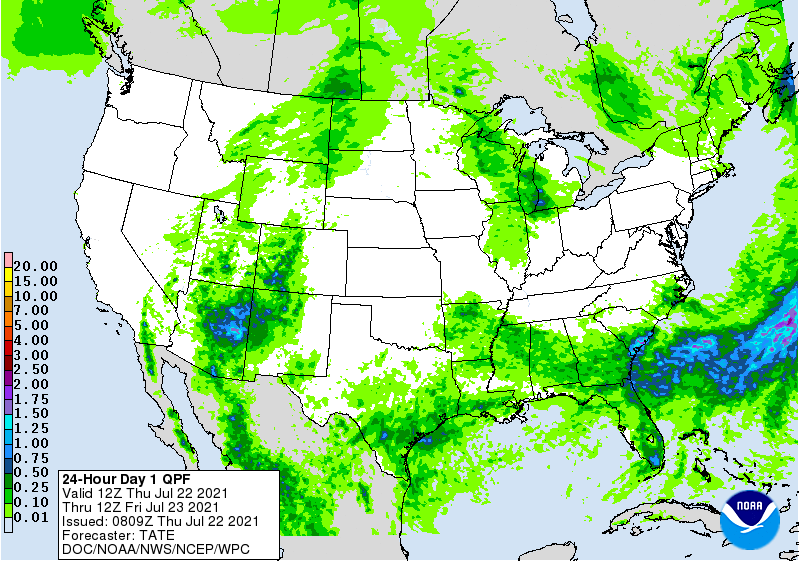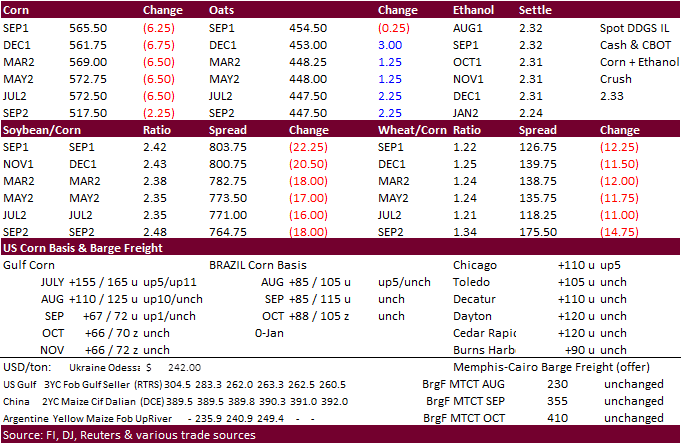PDF Attached
Other
than rice and nearby Minneapolis wheat, CBOT agriculture commodities traded lower as weather models indicated improving conditions for the US WCB and north of the US border. Northern and western Alberta will see rain fall periodically. Northern Saskatchewan
and parts of Manitoba will also get some showers. For the US, models suggest a cooler than expected August. Following the hot temperatures over the next week, rain will develop across the WCB and upper Great Plains around the end of this month. There are
still issues across other parts of the world, most notably China flooding, which in turn could increase their already large appetite for imported grains. USDA export sales were poor, IMO, except for all-wheat.
![]()
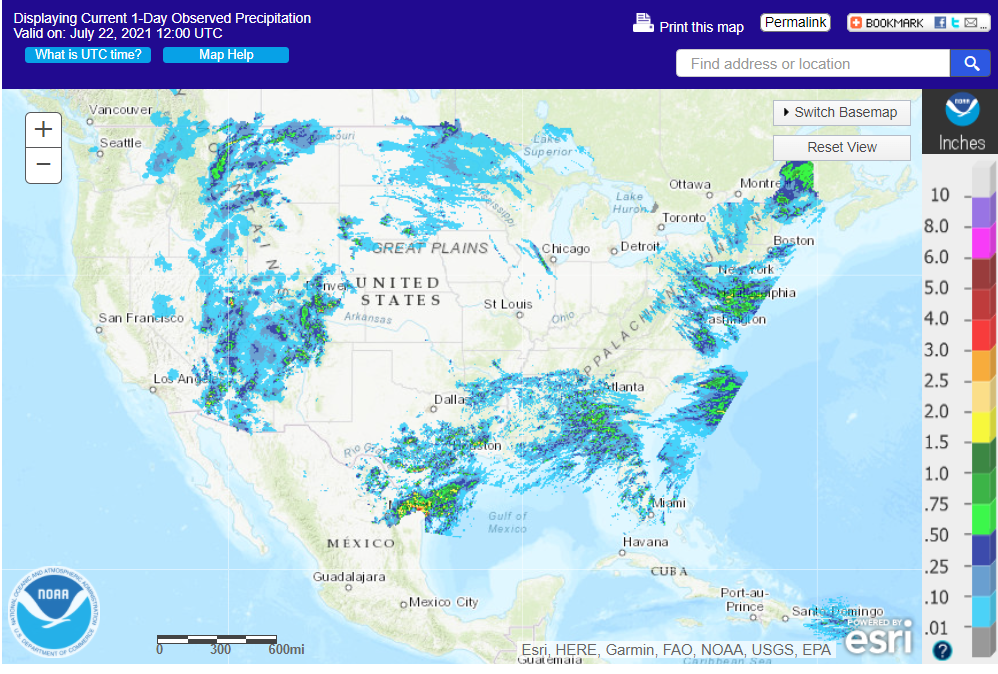
Day
1
Day
2
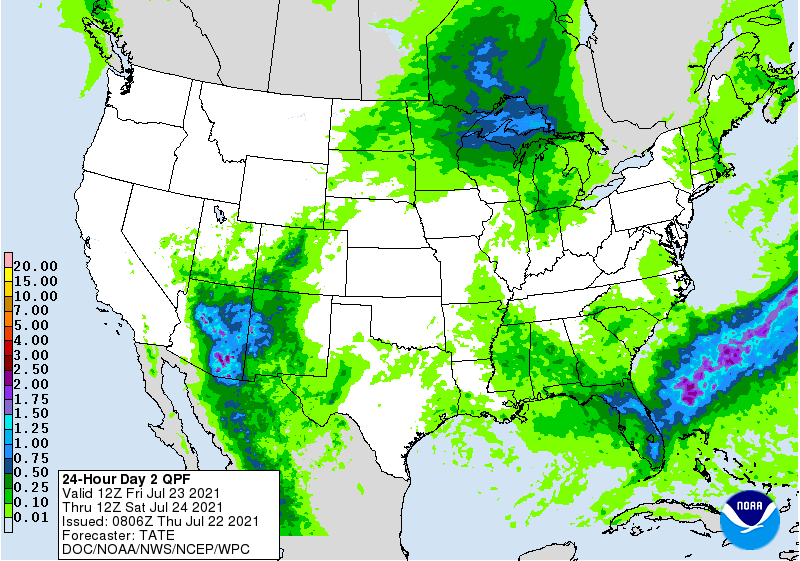
7-day
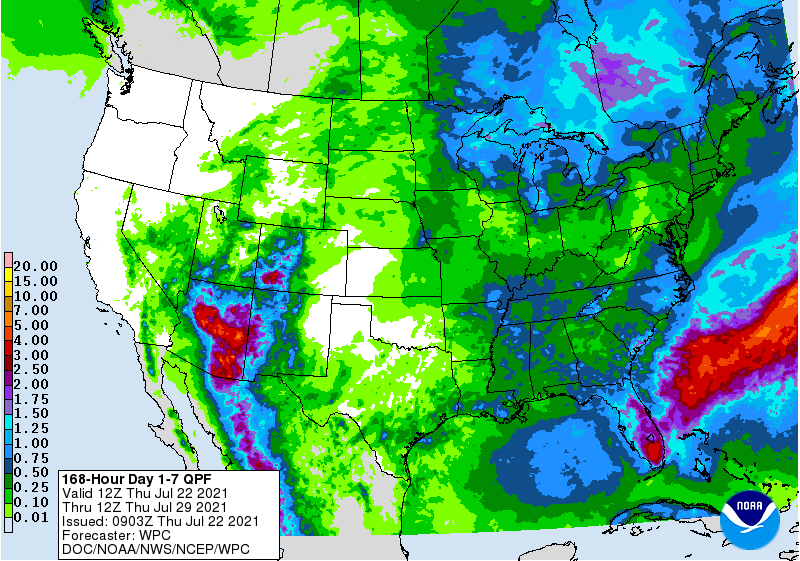
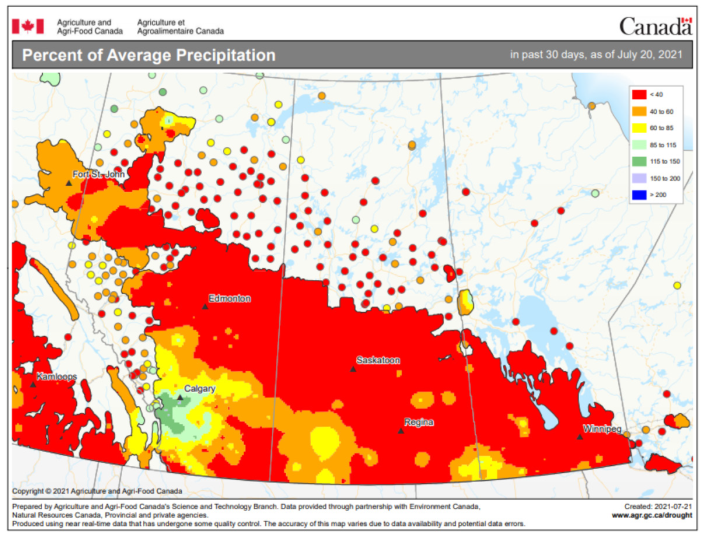
WORLD
WEATHER INC.
MOST
IMPORTANT WEATHER OF THE DAY
-
Another
day of torrential rain and serious flooding occurred from central and eastern Henan into Hebei, China Wednesday.
-
Another
30.00 inches of rain fell in northeastern Henan Wednesday after a similar amount occurred Tuesday in north-central parts of the province -
Rain
totals in the past six days have reached 40-45 inches across these north-central and northeastern Henan locations resulting in horrific flooding -
World
Weather, Inc. estimates 91,000 square miles of China crop land may be in flood because of this week’s excessive rain in Hebei and Henan alone -
Permanent
crop damage is suspected in a part of this region -
Typhoon
In-Fa is still expected to bring torrential rain, flooding and damaging wind to Zhejiang, China this weekend -
Rainfall
of 10.00 to 20.00 inches will result in serious flooding with a potential impact on rice and many other crops
-
Western
Guangdong China reported over 10.00 inches of rain Wednesday from Tropical Depression Cempaka -
Flooding
was most significant near the coast and may have impacted a small part of the province’s rice
-
Cempaka
will move through the northeastern Gulf of Tonka later today and then turn to the east and pass through Hainan, China -
Most
of the storm’s intensive rain will drift off into Vietnam limiting the impact on Hainan -
U.S.
forecast models are too wet in the western Corn Belt during the first week of August today -
A
cool northwesterly flow pattern is expected to evolve aloft, but the frontal boundary and waves of rain advertised in that first week of the month is way overboard and future model runs will have to trend a little drier -
Some
rain is expected when the cool air comes into the Midwest, but the amounts advertised are too great and occur too often in the western crop areas -
U.S.
outlook in this first week of the outlook is warm and dry in the western Corn Belt with some hot temperatures in the Plains -
The
environment will dry down the topsoil and raise some crop and livestock stress, but if the second week outlook trends cooler and wetter as suggested today there might not be much impact from this first week of warm and dry conditions -
Confidence
is high that cooling will take place in August, but the changes to wet and cool weather today are overdone -
Texas
weather will be mostly good for all summer crops -
Restricted
rain and warmer temperatures will slowly firm up the soil and stimulate more aggressive crop development in those areas with abundant soil moisture -
Dry
weather in South Texas after Friday will be good for early cotton maturation and the start of harvesting -
U.S.
far western states will continue dry biased through the next ten days with warm temperatures, but no oppressive heat -
Monsoon
moisture in the southern Rocky Mountain region and Arizona will be frequent and significant enough to improve soil moisture and induce a little runoff -
Crop
conditions will steadily improve in Arizona because of expected rainfall -
Portions
of Canada’s Prairies will continue to suffer from ongoing dryness -
Central,
northern and western Alberta will experience the most significant rainfall during the next ten days translating into improving crop development -
Temperatures
are not quite as oppressively hot in Canada as they have been in the past and that is slowing the decline in crop conditions, but the trend remains -
Southeast
Canada’s corn, soybean and wheat conditions are rated favorably and weather conditions during the next two weeks will be favorably mixed -
Brazil
weather Wednesday and early today produced no more threatening cold and conditions were dry -
A
new bout of cooling is expected late next week and into the following weekend, but confidence over another wave of crop damaging cold is low for sugarcane, citrus and coffee areas -
Wheat
production areas in southern Brazil could be negatively impacted -
Brazil
will see some periodic rain in the south during the next ten days -
Argentina
weather will be mostly dry over the next ten days -
Some
winter wheat would welcome rain especially in the west, but crop conditions are much better than last year at this time -
Crops
are mostly semi-dormant right now -
No
meaningful precipitation fell during the weekend -
Europe
is taking a break from frequent rain that occurred from eastern France to Poland last week and during the weekend -
The
drier weather is needed -
Too
much rain too often delayed small grain maturation and harvest progress and reduced crop quality -
Some
winter oilseed conditions may have also been compromised -
Rain
will return to Europe from France to Poland this weekend and next week possibly delaying fieldwork and returning concern over unharvested winter crop quality -
Russia’s
Southern New Lands and northwestern Kazakhstan will receive rain over the next two days -
The
moisture will be good for developing crops and should reduce heat and moisture stress that has evolved recently -
More
rain will be needed soon, though -
Net
drying will continue in northwestern Russia for a while possibly resulting in a little crop moisture stress for the driest areas -
Rain
may improve in these areas next week -
Some
net drying is expected in central Ukraine and parts of southwestern Russia over the coming ten days, despite some shower activity -
A
few areas may become a little too dry and crop stress may increase -
Rain
will be needed soon to protect production potentials -
Southwestern
Xinjiang, China was unusually cool again Wednesday due to rain -
High
temperatures were in the 80s and lower 90s northeast and only in the upper 60s and 70s in the far west
-
Rainfall
in the far west ranged up to 1.57 inches with as much as 2.75 inches at one location.
-
Warming
and drier weather will occur over the next week -
Xinjiang
degree day accumulations continue behind normal -
Warming
is needed and expected along with drier weather -
India
rainfall over the next two weeks will slowly increase bringing rain to most of the nation and improve crop and field conditions over time
-
There
is some concern over net drying in the far south and extreme northwest, but most other areas will receive sufficient rain to bolster soil moisture and support improving crop development and long term moisture supply -
Ivory
Coast and Ghana rainfall will be restricted over the next couple of weeks -
Seasonal
rainfall should return normally in September, but August rainfall will be lighter than usual -
Other
areas in West Africa will see a better distribution of rain -
East-central
Africa rainfall will continue favorable for coffee and cocoa, although some areas in Uganda and Kenya may receive less than usual rainfall -
Ethiopia
rainfall is expected to continue improving after a slow start to the rainy season -
Southern
Oscillation Index has reached back about +14.43 and it is expected to remain strongly positive this week while slowly leveling off after a strong rising trend since June 22 when the index was -3.36 -
Southeast
Asia rainfall recently and that which is expected in the next two weeks will continue somewhat erratic
-
Laos,
Cambodia and northern Philippines will see the greatest rainfall -
Southern
Sumatra and Java, Indonesia may experience less than usual rainfall for a while -
Thailand
will also experience less than usual rainfall in pockets, although there has been some beneficial moisture recently -
Australia
weather this month has been ideal for improving winter wheat, barley and canola establishment in much of the nation -
Some
additional rain is still needed in South Australia, northwestern Victoria and from western New South Wales to Queensland -
South
Africa has been cold during the past week with waves of rain in the southwest -
Weekend
rainfall was still cool, but rain ended in many areas -
The
moisture has been good for future wheat development -
Dryness
remains in some of the unirrigated eastern wheat production areas -
Some
warming is expected over the coming week, but the precipitation anomalies will prevail -
Mexico
weather has improved with increased rainfall in the south and west parts of the nation -
Drought
conditions are waning and crops are performing better -
Dryness
remains in Chihuahua and northeastern parts of the nation -
Weather
over the next ten days will offer some relief, but more rain will be needed in the drier areas -
Central
America rainfall has been plentiful and will remain that way except in Honduras where recent rainfall has been lighter and more sporadic than usual -
Nicaragua
has received frequent bouts of rain this month easing long term dryness, but more may be needed in some locations -
New
Zealand rainfall during the coming week will be near to above normal in North Island and western portions of South Island while below average in eastern South Island -
Temperatures
will be seasonable
Source:
World Weather Inc.
Bloomberg
Ag Calendar
Thursday,
July 22:
- USDA
weekly crop net-export sales for corn, soybeans, wheat, cotton, pork, beef, 8:30am - USDA
to release world supply-demand outlook for orange and its juice - Port
of Rouen data on French grain exports - USDA
total milk, red meat production - U.S.
cold storage data – pork, beef, poultry - HOLIDAY:
Japan
Friday,
July 23:
- ICE
Futures Europe weekly commitments of traders report (6:30pm London) - CFTC
commitments of traders weekly report on positions for various U.S. futures and options, 3:30pm - FranceAgriMer
weekly update on crop conditions - U.S.
cattle on feed, poultry slaughter, cattle inventory - HOLIDAY:
Japan
Source:
Bloomberg and FI
USDA
Export Sales
USDA
export sales were poor for corn, soybean meal (marketing year low) and soybean oil. Soybeans were on the low side of expectations and wheat was within. The report is viewed negative for the soybean complex and corn. Pork sales were ok at 24,500 tons and
included 10k for Mexico. There were 52,200 tons of sorghum sales, for Japan and Mexico.
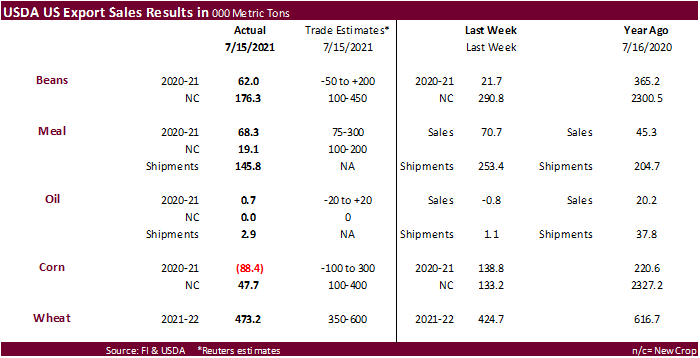

73
Counterparties Take $898.197 Bln At Fed’s Fixed-Rate Reverse Repo (prev $886.206 Bln, 71 Bidders)
US
Initial Jobless Claims Jul 17: 419K (est 350K; prevR 368K; prev 360K)
US
Continuing Claims Jul 10: 3236K (est 3100K; prevR 3265K; prev 3241K)
US
Existing Home Sales Change Jun: 5.86M (est 5.90M; prev 5.80M)
–
Existing Home Sales (M/M) Jun: 1.4% (est 1.7%; prev -0.9%)
–
Inventory Of Homes For Sale Jun: 1.25 Mln Units, 2.6 Month’s Worth (prev 1.23 Mln Units, 2.5 Months)
–
National Median Home Price For Existing Homes Jun: 363.3K, +23.4% (prev $350,300, +23.6%From May 2020)
US
EIA Natural Gas Storage Change (BCF) 16-Jul: +49 (est +43; prev +49)
–
Salt Dome Cavern Natural Gas Storage Change (BCF): -4 (prev -3)
US
NatGas Rises To $4, First Time Since December 2018
Corn
- Corn
opened sharply
lower on weather models suggesting a slightly wetter bias for the WCB. Price declines paired some losses by afternoon trading. September closed 7.25 cents lower at $5.6450 and December fell 7.25 to $5.6125. Looking back at the last couple weeks, the charts
suggest a sideways trading range for old and new crop. A break above $5.7350 basis the December contract could generate some buying.
- Looking
forward, we see the US corn condition unchanged to down one-point next week when updated by USDA. Also, next week we should see private US corn estimates released, a previous for the upcoming August S&D report.
- China
saw another day of torrential rain from central and eastern Henan into Hebei. 30 inches of rain fell in northeastern Henan Wednesday after a similar amount occurred Tuesday across the north-central areas. It might be time to think again about China demand.
After recent flooding in China that likely damaged summer crops, this could increase Chinese import demand from what is already projected by USDA for grains and at a lesser extent, oilseeds, since China plants more grains than oilseeds. Question remains by
how much? - China’s
National Meteorological Center said the Henan floods may have only a minor impact on corn and the overall impact on production is “not significant.” They noted the flooded area accounted for just 12% of the total corn area in Henan. We may see some crop loss
but overall total China corn production is easily expected to eclipse last year. We are also in the camp USDA is too high on their 26 million ton import estimate for new-crop (2020-21). FI is using 22 million tons. Note China bought nearly 11 million tons
of US new-crop corn, according to USDA export sales. - Henan
is one of two provinces with the highest amount of farming acreage in China. Hebei ranks around seventh largest. Back to Henan, about 27 percent of China’s all-wheat crop is grown in that province. For corn, Henan makes up about 9 percent of total production.
World Weather, Inc. estimates 91,000 square miles (23.6 million hectares) of China area may be impacted by flooding. We are unsure how much of that is of farmland. World Weather inc. later noted “In Hebei the worst conditions were in the western 40% of the
province while in Henan the worst conditions occurred from the south through the northeast.” It’s difficult to calculate production areas impacted due to lack of available detailed mapping.
- Typhoon
In-Fa is still expected to bring torrential rain, flooding and damaging wind to Zhejiang, China this weekend (World Weather and FI).
- Inserted
after the wheat comment are USDA’s crop areas for corn, soybean, and wheat by China province, for reference.
- Below
are total acres versus oilseeds & grains. 2021-22 is FI projection.
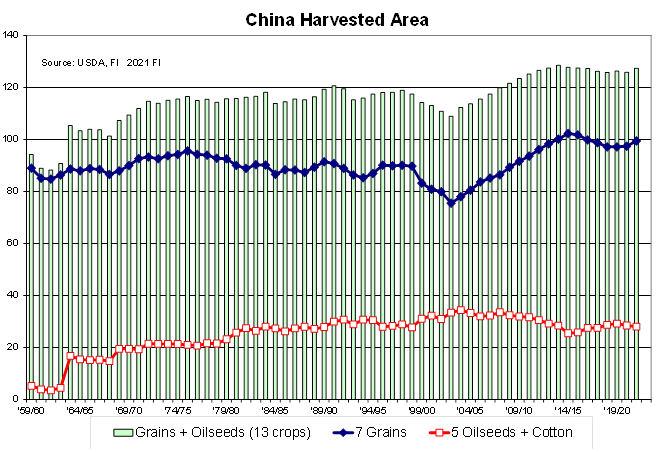
- We
think the $5.88 CBOT September corn gap is still not out of reach.
Export
developments.
- Jordan
seeks 120,000 tons of feed barley on July 28 for Nov/Dec shipment.

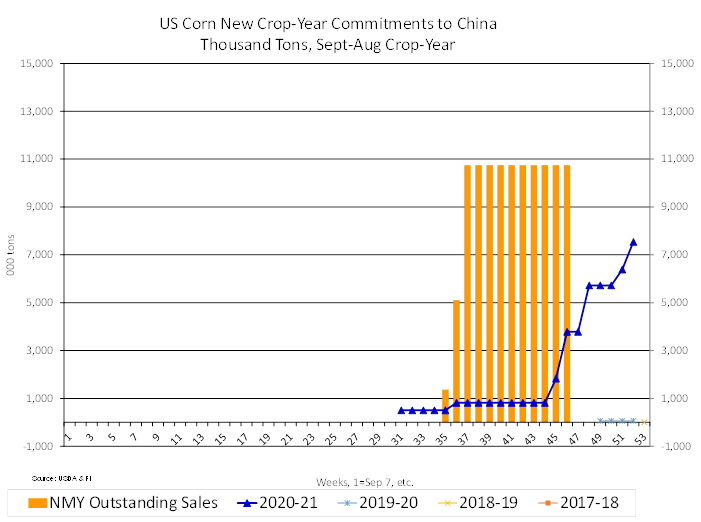
Updated
07/13/21
September
corn is seen is a $4.75-$6.25 range
December
corn is seen in a $4.25-$6.00 range.
Soybeans
-
It
came as a surprise that the soybean complex traded sharply lower this morning. Some of the losses were paired by afternoon trading. Soybean meal initially saw limited losses from a 125-160 point decline in soybean oil but after soybean oil recovered, meal
prices were pressured despite India’s SEA (crush association) request to the government to consider allowing imports of soybean meal to boost supplies. India has been playing catchup on replenishing vegetable oil supplies recently. They will likely buy the
soybean meal from Argentina like they do for soybean oil. -
August
soybeans fell 23 cents, August meal down $6.60, and August soybean oil off 46 points. The back months for soybeans and products were weaker than August. We are unclear what triggered the bull spreading sentiment as spot US domestic demand has slowed. USDA
may lower the current crop year crush by 10 million bushels in the August S&D update.
-
For
US soybeans, US weather was the main feature for the surprise selloff. Fundamental news was light. It seems until we get the August
Crop
Production report,
prices will be largely influenced by changes in the US weather models. Note private US crop production estimates will start to trickle out next week which could impact prices over the short term. Our August estimates will be set late Monday afternoon post
USDA crop progress report. Currently we look for an unchanged US soybean G/E rating for this week.
-
November
Canadian canola, in a remarkable trade, closed slightly higher at 881.30/ton, erasing nearly all its losses during the session. The contract failed to test its 20-day MA.
- South
Korea’s Agro-Fisheries & Food Trade Corp. bought 4,000 tons of non-GMO soybeans, as expected, at $948.72/ton for arrival between Sep 10 and Oct 20.
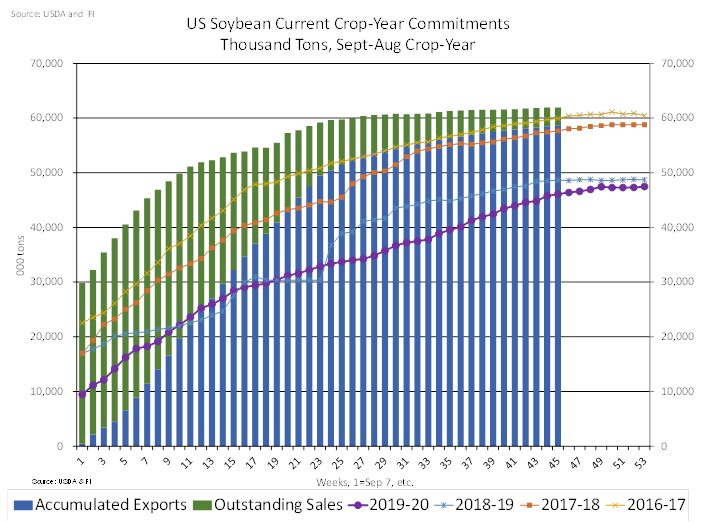
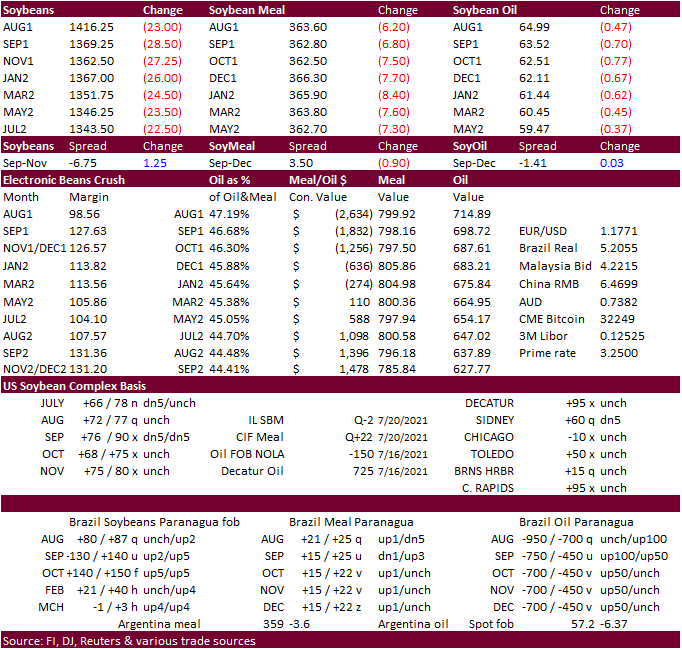
Updated
7/21/21
August
soybeans are seen in a $13.25-$15.25 range; November $11.75-$15.00
August
soybean meal – $330-$410; December $320-$425
August
soybean oil – 64.50-70.00; December 48-67 cent range
- US
wheat opened
sharply lower in all three markets following corn and soybeans but a rebound in Minneapolis wheat paired some losses for KC and Chicago. The USD was up 14 points as of 1 pm CT. Parts of the northern spring wheat areas are expected to see rain. This theme
and an improving weather situation for selected parts of Canada added to the negative undertone set by the soybean and corn market earlier. However, after MN wheat plunged early, that provided a buying opportunities for commercials. The September MN wheat
contract closed 6.25 cents higher at $9.0400. September Chicago wheat ended 18.50 cents lower, and September KC was down 15 cents.
- USDA
export sales were good for all-wheat. Usual suspects were reported. - Harvesting
pressure added to the negative undertone for KC wheat. Spring wheat harvesting started, and we could see a 1-3 percent progress figure is updated by USDA on Monday.
- Russia’s
Southern Region and parts of the dry areas of Kazakhstan will see rain through Friday evening. This is welcome. Russia’s wheat harvest is lagging last year and average.
- December
Paris wheat was down 3.25 at 313.00 euros. - Consultancy
Strategie Grains lowered their French 2021 soft wheat production after a crop tour showed lower than expected yields in the northeastern region, between 37.0 and 37.5 million tons from 38 previous. This compares to the French AgMin estimate of 37.1 million
tons, and well up from 29 million tons of soft wheat collected in 2020.
- Results
awaited: Ethiopia seeks 400,000 tons of wheat on July 19.
- Pakistan’s
TCP seeks 500,000 tons of wheat on July 27. 200,000 tons are for August shipment, and 300,000 tons are for September shipment.
Rice/Other
-
Mauritius
seeks 6,000 tons of white rice on July 27 for October through December shipment.
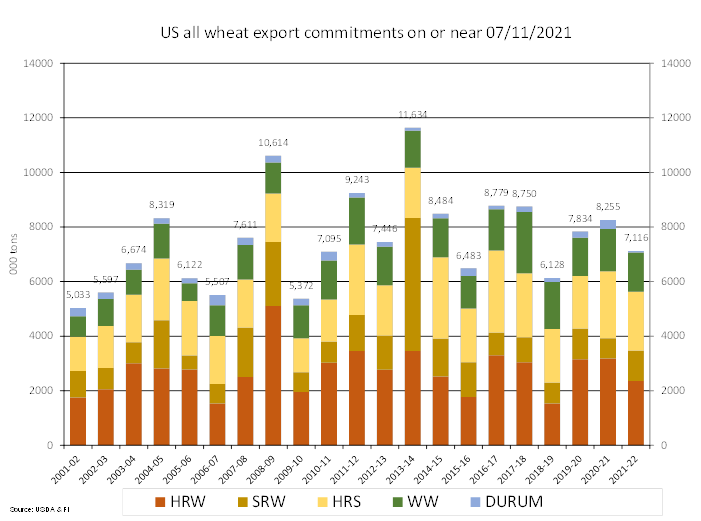
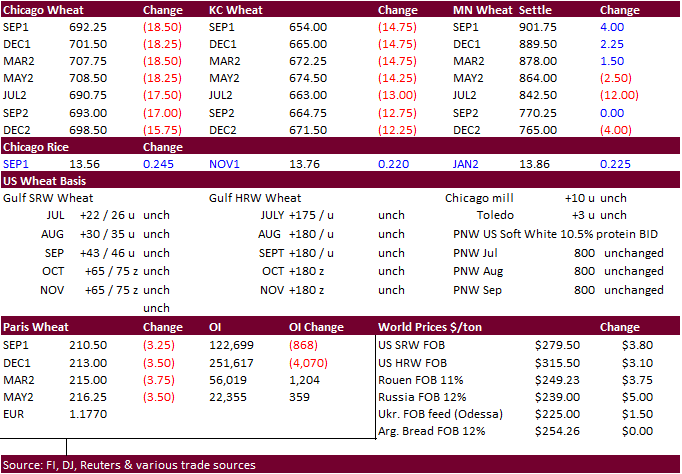
Updated
7/21/21
September Chicago wheat is seen in a $6.25-$7.50 range
September KC wheat is seen in a $5.90-$7.25
September MN wheat is seen in a $7.75-$9.50
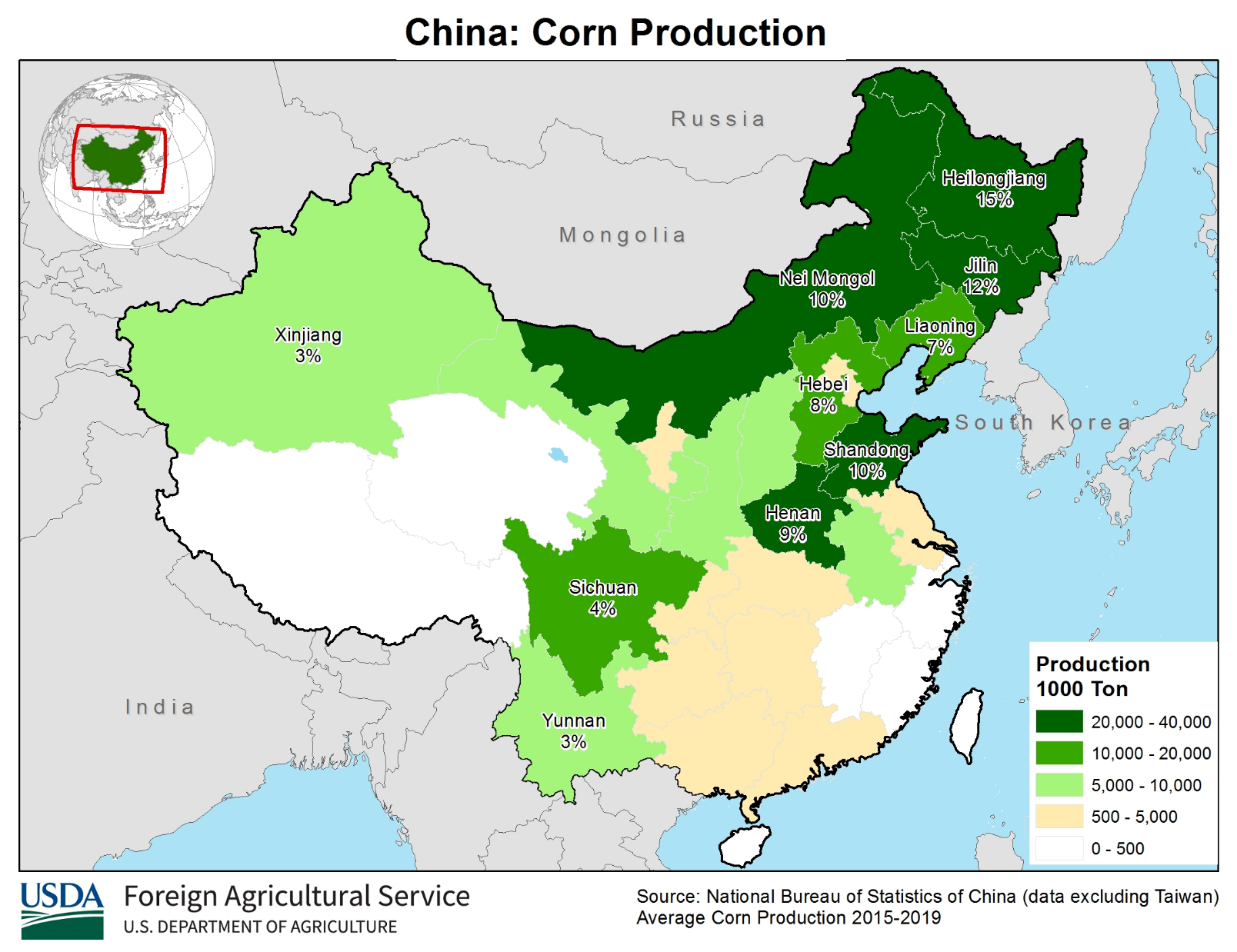
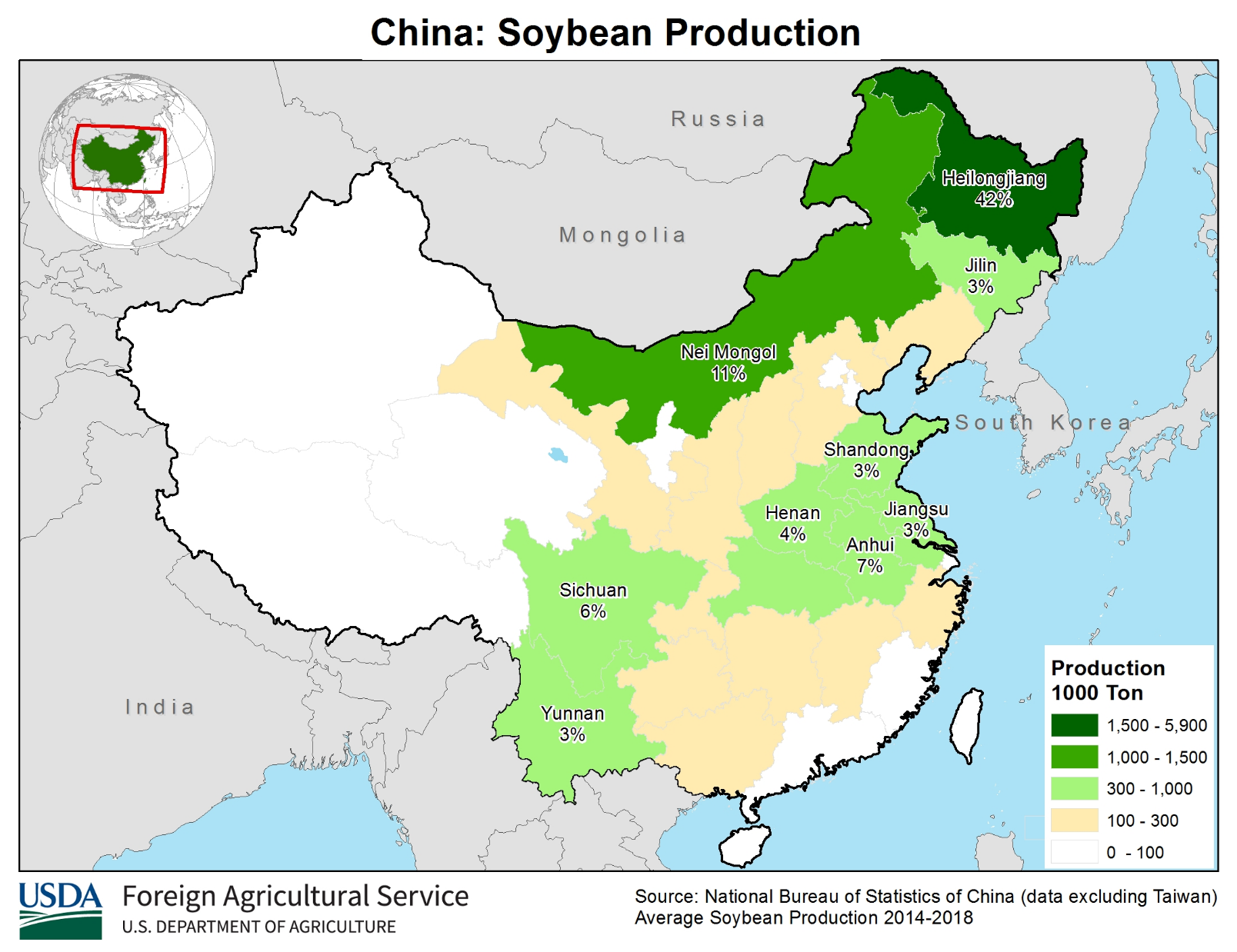
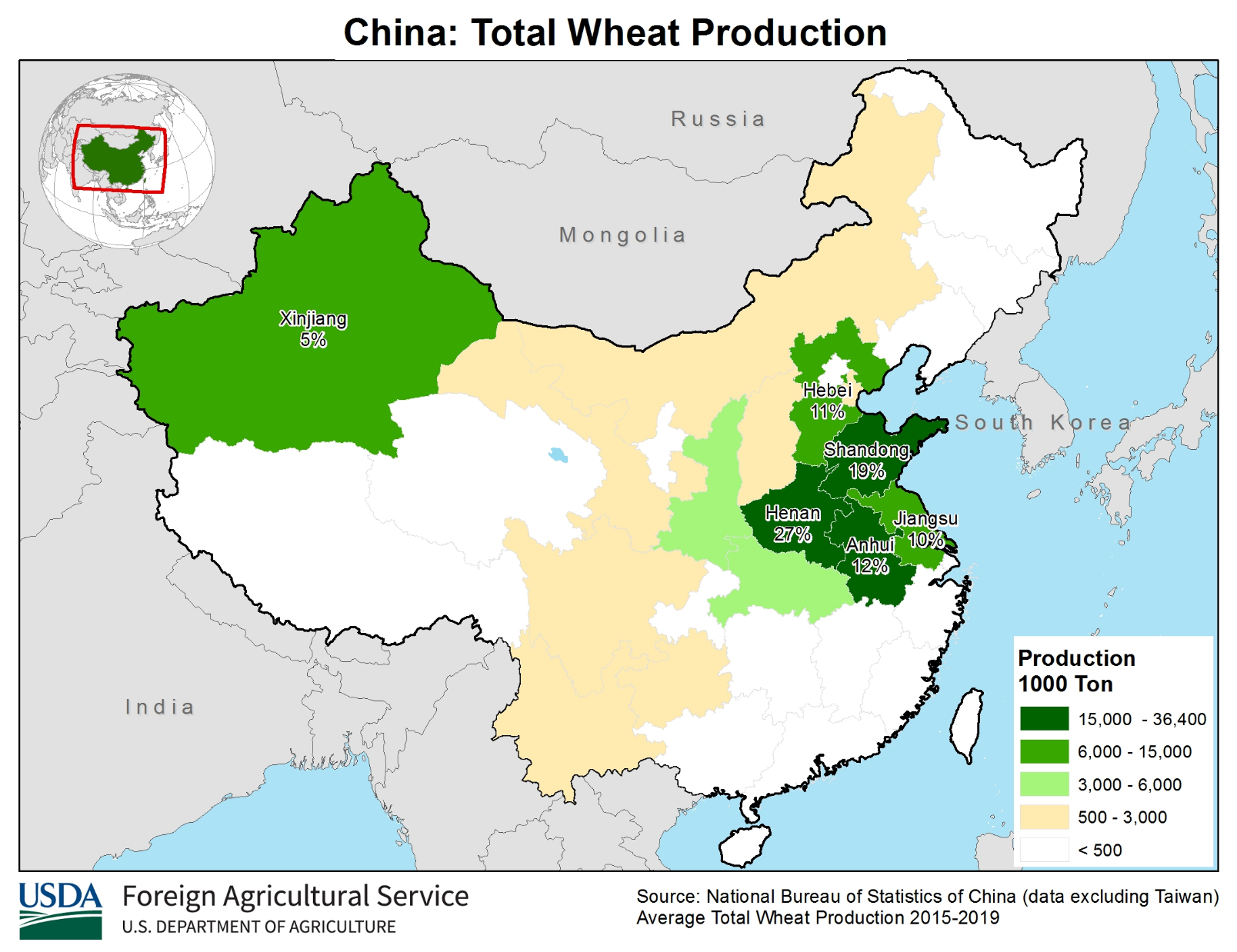
USDA export sales were poor for corn, soybean meal (marketing year low) and soybean oil. Soybeans were on the low side of expectations and wheat was within. The report is viewed negative for the soybean complex and
corn. Pork sales were ok at 24,500 tons and included 10k for Mexico. There were 52,200 tons of sorghum sales, for Japan and Mexico.
U.S. EXPORT SALES FOR WEEK ENDING 07/15/2021
|
|
CURRENT MARKETING YEAR |
NEXT MARKETING YEAR |
||||||
|
COMMODITY |
NET SALES |
OUTSTANDING SALES |
WEEKLY EXPORTS |
ACCUMULATED EXPORTS |
NET SALES |
OUTSTANDING SALES |
||
|
CURRENT YEAR |
YEAR |
CURRENT YEAR |
YEAR |
|||||
|
|
THOUSAND METRIC TONS |
|||||||
|
WHEAT |
|
|
|
|
|
|
|
|
|
HRW |
137.0 |
1,631.1 |
1,695.6 |
119.5 |
858.9 |
1,618.0 |
0.0 |
0.0 |
|
SRW |
184.6 |
967.4 |
675.6 |
101.7 |
332.6 |
213.6 |
5.0 |
5.0 |
|
HRS |
113.5 |
1,533.0 |
1,770.1 |
165.3 |
742.3 |
838.3 |
0.0 |
0.0 |
|
WHITE |
38.0 |
1,065.1 |
1,172.2 |
84.5 |
408.2 |
496.2 |
0.0 |
0.0 |
|
DURUM |
0.0 |
8.4 |
203.0 |
0.0 |
41.7 |
158.8 |
0.0 |
0.0 |
|
TOTAL |
473.2 |
5,205.1 |
5,516.5 |
471.0 |
2,383.7 |
3,324.8 |
5.0 |
5.0 |
|
BARLEY |
0.0 |
23.5 |
36.6 |
0.2 |
1.6 |
2.1 |
0.0 |
0.0 |
|
CORN |
-88.5 |
9,019.4 |
6,678.2 |
1,003.5 |
60,751.2 |
37,032.1 |
47.7 |
16,127.4 |
|
SORGHUM |
-52.2 |
710.9 |
802.2 |
59.0 |
6,467.4 |
3,558.1 |
0.0 |
1,594.9 |
|
SOYBEANS |
62.0 |
3,132.2 |
7,865.4 |
164.1 |
58,855.8 |
38,529.1 |
176.3 |
9,864.9 |
|
SOY MEAL |
68.3 |
2,069.7 |
1,719.0 |
145.8 |
9,519.9 |
9,691.2 |
19.1 |
1,057.3 |
|
SOY OIL |
0.7 |
16.9 |
225.2 |
2.9 |
660.3 |
1,018.9 |
0.0 |
0.6 |
|
RICE |
|
|
|
|
|
|
|
|
|
L G RGH |
40.5 |
189.8 |
93.3 |
35.5 |
1,611.3 |
1,329.4 |
5.0 |
5.0 |
|
M S RGH |
0.0 |
8.0 |
23.6 |
0.3 |
25.9 |
72.9 |
0.0 |
7.0 |
|
L G BRN |
0.1 |
11.5 |
10.1 |
0.4 |
40.0 |
58.8 |
0.0 |
0.7 |
|
M&S BR |
0.1 |
0.7 |
31.7 |
22.3 |
156.2 |
86.5 |
0.0 |
0.0 |
|
L G MLD |
29.7 |
46.8 |
52.4 |
18.0 |
645.5 |
859.5 |
0.3 |
0.3 |
|
M S MLD |
2.8 |
113.0 |
83.9 |
3.8 |
579.8 |
661.3 |
0.1 |
12.3 |
|
TOTAL |
73.2 |
369.7 |
294.9 |
80.3 |
3,058.6 |
3,068.5 |
5.4 |
25.3 |
|
COTTON |
|
THOUSAND RUNNING BALES |
||||||
|
UPLAND |
40.0 |
1,825.3 |
3,542.8 |
246.1 |
14,365.5 |
13,463.4 |
251.9 |
2,972.4 |
|
PIMA |
3.4 |
103.3 |
135.6 |
10.4 |
733.8 |
458.8 |
0.9 |
5.4 |
This
summary is based on reports from exporters for the period July 9-15, 2021.
Wheat: Net
sales of 473,200 metric tons (MT) for 2021/2022 were up 11 percent from the previous week and 44 percent from the prior 4-week average. Increases primarily for China (135,300 MT, including decreases of 3,300 MT), the Philippines (122,800 MT, including decreases
of 1,000 MT), Mexico (118,400 MT, including decreases of 2,800 MT), Nigeria (43,700 MT), and Ecuador (41,800 MT, including 41,300 MT switched from unknown destinations), were offset by reductions primarily for Vietnam (53,000 MT). Total net sales for 2022/2023,
of 5,000 MT were for unknown destinations. Exports of 471,000 MT were up 29 percent from the previous week and 28 percent from the prior 4-week average. The destinations were primarily to the Philippines (118,800 MT), Mexico (67,700 MT), China (63,500 MT),
Nigeria (48,700 MT), and Ecuador (41,800 MT).
Corn:
Net sales reductions of 88,500 MT for 2020/2021 were down noticeably from the previous week and from the prior 4-week average. Increases primarily for Japan (57,300 MT, including 43,700 MT switched from unknown destinations and 12,000 MT – late), Panama (20,700
MT), Colombia (10,800 MT, including decreases of 200 MT), Nicaragua (7,500 MT, switched from Honduras), and Canada (6,700 MT), were more than offset by reductions primarily for China (160,000 MT). For 2021/2022, net sales of 47,700 MT were primarily for Japan
(18,000 MT), Honduras (9,100 MT), Mexico (9,000 MT), Nicaragua (7,500 MT), and El Salvador (1,300 MT). Exports of 1,003,500 MT were down 6 percent from the previous week and 22 percent from the prior 4-week average. The destinations were primarily to China
(526,000 MT), Mexico (235,900 MT), Japan (95,400 MT, including 12,000 MT – late), Venezuela (47,100 MT), and Nicaragua (27,400 MT).
Optional
Origin Sales: For 2020/2021, the current outstanding balance of 30,500 MT is for unknown destinations. For 2021/2022, the current outstanding balance of 60,000 MT is for unknown destinations.
Late
Reporting: For 2020/2021, net sales and exports totaling 12,000 MT of corn were reported late to Japan.
Sorghum:
Net sales reductions of 52,200 MT for 2020/2021 resulting in increases for Mexico (900 MT) and Japan (100 MT), were more than offset by reductions for China (53,200 MT).
Exports of 59,000 MT were down 17 percent from the previous week, but up noticeably from the prior 4-week average. The destinations were to China (58,800 MT) and Mexico (200 MT).
Rice:
Net sales of 73,200 MT for 2020/2021 were up noticeably from the previous week and from the prior 4-week average. Increases primarily for Haiti (27,500 MT), Venezuela (25,100 MT), Mexico (16,100 MT), Canada (2,000 MT), and Jordan (1,400 MT), were offset by
reductions for Guatemala (1,000 MT). For 2021/2022, net sales of 5,400 MT were primarily for Guatemala (5,000 MT), Costa Rica (200 MT), and Leeward Windward Islands (100 MT).
Exports of 80,300 MT were up 24 percent from the previous week and 53 percent from the prior 4-week average. The destinations were primarily to Venezuela (26,300 MT), South Korea (22,200 MT), Haiti (15,300 MT), Honduras (5,500 MT), and Mexico (4,400 MT).
Exports
for Own Account: For 2020/2021, the current exports for own account outstanding balance is 100 MT, all Canada.
Soybeans:
Net sales of 62,000 MT for 2020/2021 were up noticeably from the previous week, but down 22 percent from the prior 4-week average. Increases primarily for Japan (85,300 MT, including 53,200 MT switched from unknown destinations and decreases of 4,400 MT),
Mexico (13,100 MT, including decreases of 11,300 MT), Colombia (9,100 MT, including 8,500 MT switched from unknown destinations), Malaysia (5,600 MT), and Taiwan (5,000 MT), were offset by reductions primarily for unknown destinations (58,200 MT). For 2021/2022,
net sales of 176,300 MT were reported for unknown destinations (97,000 MT), Mexico (67,400 MT), China 6,000 MT), Taiwan (5,000 MT), and Vietnam (900 MT). Exports of 164,100 MT were down 17 percent from the previous week and 19 percent from the prior 4-week
average. The destinations were primarily to Mexico (60,300 MT), Japan (57,300 MT), Indonesia (22,000 MT), Colombia (9,100 MT), and Vietnam (4,400 MT).
Exports
for Own Account: For 2020/2021, the current exports for own account outstanding balance is 5,800 MT, all Canada.
Soybean
Cake and Meal: Net sales of 68,300 MT for 2020/2021–a marketing-year low–were down 3 percent from the previous week and 70 percent from the prior 4-week average. Increases primarily for Ireland (28,500 MT, including 30,000 MT switched from Poland and
decreases of 1,500 MT), Colombia (25,000 MT), unknown destinations (12,500 MT), Panama (7,100 MT), and Canada (6,700 MT, including decreases of 900 MT), were offset by reductions primarily for Poland (30,000 MT), the French West Indies (6,500 MT), and Nicaragua
(5,500 MT). For 2021/2022, net sales of 19,100 MT were primarily for Canada (15,500 MT), Mexico (2,800 MT), and Guatemala (500 MT).
Exports of 145,800 MT were down 43 percent from the previous week and 19 percent from the prior 4-week average. The destinations were primarily to the Philippines (49,400 MT), Ireland (28,500 MT), Canada (21,300 MT), Mexico (17,100 MT), and Honduras (7,500
MT).
Soybean
Oil: Net sales of 700 MT for 2020/2021 were down noticeably from the previous week and down 16 percent from the prior 4-week average. Increases were reported for Mexico (400 MT) and Canada (300 MT). Exports of 2,900 MT were up noticeably from the previous
week, but down 13 percent from the prior 4-week average. The destinations were to Mexico (2,400 MT) and Canada (500 MT).
Exports
for Own Account: For 2020/2021, the current exports for own account outstanding balance of 5,700 RB is for China (4,700 RB) and Vietnam (1,000 RB).
Late
Reporting: For 2020/2021, net sales and exports totaling 5,100 RB of upland cotton were reported late for Pakistan.
Hides
and Skins: Net sales of 355,800 pieces for 2021 were up 6 percent from the previous week, but down 32 percent from the prior 4-week average. Increases were primarily for China (192,300 whole cattle hides, including
decreases of 6,600 pieces), South Korea (71,200 whole cattle hides, including decreases of 1,100 pieces), Mexico (41,000 whole cattle hides, including decreases of 1,400 pieces), Taiwan (26,500 whole cattle hides), and Brazil (14,900 whole cattle hides).
Exports of 525,500 pieces were up 85 percent from the previous week and 54 percent from the prior 4-week average. Whole cattle hides exports were primarily to China (364,000 pieces), South Korea (83,000 pieces), Mexico (36,800 pieces), Thailand (27,600 pieces),
and Brazil (8,100 pieces).
Net
sales of 278,300 wet blues for 2021 were up 7 percent from the previous week and 58 percent from the prior 4-week average. Increases were primarily for China (73,400 unsplit, 14,700 grain splits, and decreases of 100 unsplit), Vietnam (80,400 unsplit, including
decreases of 200 unsplit), Italy (52,400 unsplit, 100 grain splits, and decreases of 100 unsplit), Thailand (24,400 unsplit, including decreases of 400 unsplit), and Taiwan (23,600 unsplit). For 2022, net sales of 29,200 unsplit were reported for Italy (21,600
unsplit), Vietnam (4,000 unsplit), and China (3,600 unsplit). Exports of 185,600 wet blues were up 50 percent from the previous week and 41 percent from the prior 4-week average. The destinations were to China (40,800 unsplit and 18,000 grain splits), Italy
(37,500 unsplit and 3,200 grain splits), Vietnam (28,700 unsplit), Taiwan (15,000 unsplit), and Thailand (14,400 unsplit). Net sales of 157,500 splits resulting in increases for China (159,400 pounds), were offset by reductions for Vietnam (1,800 pounds).
Exports of 204,000 pounds were to Vietnam (160,000 pounds) and China (44,000 pounds).
Beef:
Net sales of 25,100 MT reported for 2021 were up noticeably from the previous week and up 63 percent from the prior 4-week average. Increases primarily for South Korea (8,600 MT, including decreases of 500 MT),
Japan (5,200 MT, including decreases of 600 MT), China (4,100 MT, including decreases of 100 MT), Canada (2,400 MT, including decreases of 100 MT), and Mexico (1,500 MT, including decreases of 100 MT), were offset by reductions for Belgium (100 MT).
Total net sales for 2022, of 300 MT were for Japan.
Exports of 21,400 MT–a marketing-year high–were up 38 percent from the previous week and 22 percent from the prior 4-week average. The destinations were primarily to South Korea (5,900 MT), Japan (5,500 MT), China (4,000 MT), Taiwan (1,500 MT), and Mexico
(1,400 MT).
Pork:
Net sales of 24,500 MT reported for 2021 were up noticeably from the previous week, but down 12 percent from the prior 4-week average. Increases primarily for Mexico (10,000 MT, including decreases of 900 MT), Japan
(5,200 MT, including decreases of 200 MT), Canada (4,000 MT, including decreases of 500 MT), Colombia (1,900 MT, including decreases of 100 MT), and Chile (900 MT, including decreases of 100 MT), were offset by reductions for China (100 MT) and Peru (100 MT).
Exports of 30,800 MT were up 22 percent from the previous week and 1 percent from the prior 4-week average. The destinations were primarily to Mexico (12,000 MT), China (5,400 MT), Japan (4,400 MT), South Korea (1,900 MT), and Canada (1,700 MT).
Terry Reilly
Senior Commodity Analyst – Grain and Oilseeds
Futures International
One Lincoln Center
18 W 140 Butterfield Rd.
Suite 1450
Oakbrook Terrace, Il. 60181
W: 312.604.1366
ICE IM:
treilly1
Skype: fi.treilly

Trading of futures, options, swaps and other derivatives is risky and is not suitable for all persons. All of these investment products are leveraged, and you can lose more than your initial deposit. Each investment product is offered
only to and from jurisdictions where solicitation and sale are lawful, and in accordance with applicable laws and regulations in such jurisdiction. The information provided here should not be relied upon as a substitute for independent research before making
your investment decisions. Futures International, LLC is merely providing this information for your general information and the information does not take into account any particular individual’s investment objectives, financial situation, or needs. All investors
should obtain advice based on their unique situation before making any investment decision. The contents of this communication and any attachments are for informational purposes only and under no circumstances should they be construed as an offer to buy or
sell, or a solicitation to buy or sell any future, option, swap or other derivative. The sources for the information and any opinions in this communication are believed to be reliable, but Futures International, LLC does not warrant or guarantee the accuracy
of such information or opinions. Futures International, LLC and its principals and employees may take positions different from any positions described in this communication. Past results are not necessarily indicative of future results.

